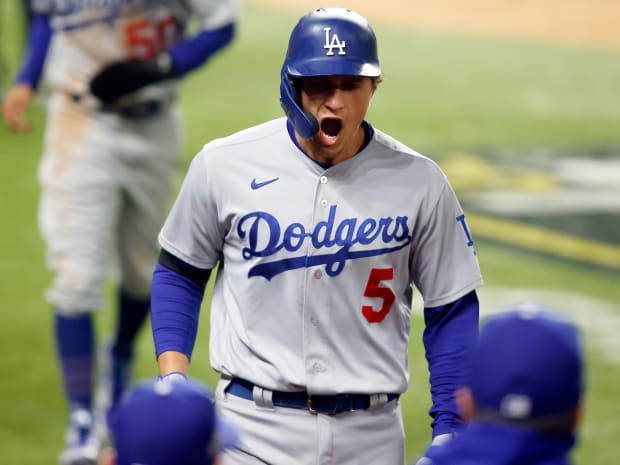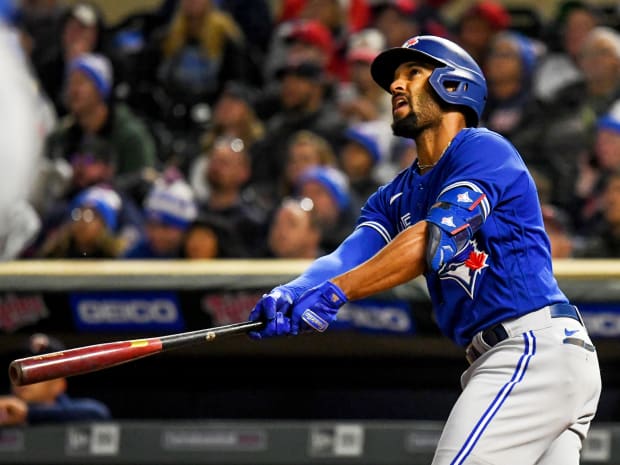They signed Corey Seager and Marcus Semien to deals worth a combined $500 million, but their 2022 outlook remains bleak.
Let’s start this off with a tip of the cap to Jon Daniels and the rest of the Rangers’ braintrust. They looked at a roster that lost 102 games in 2021 and took the flashiest, most expensive route to immediately upgrading it, spending $500 million on a pair of superstar shortstops in Corey Seager and Marcus Semien while outbidding MLB’s two richest franchises in the process. Seager’s former team (the Dodgers) and what many expected to be his future team (the Yankees) are left to either swallow their pride and bid for Carlos Correa—who’s openly antagonized both clubs—or settle for a lesser player.
This will surely thrill the millions of Rangers fans who packed the team’s new stadium last season to watch a product that didn’t deserve to lead the American League in attendance, but did anyway. In a sport rife with franchises happy to subject their fans to slow, painful rebuilds, Texas decided it didn’t want to endure multiple campaigns with triple-digit losses or extend its streak of three last-place finishes in four years.

Tim Heitman/USA TODAY Sports
But … isn’t that exactly what was seemingly bound to happen just a few months ago? At the trade deadline, the Rangers shipped off Joey Gallo and Kyle Gibson, both of whom were under team control through next season, on the premise that Texas would not be contending in 2022. That Gallo fetched a return from the Yankees based more on quantity than quality added to the perception that Texas was resigned to a few years out of the spotlight.
Instead, over the course of about 24 hours, the Rangers committed to spending $556 million on Seager (10 years, $325 million), Semien (seven years, $175 million), starting pitcher Jon Gray (four years, $56 million) and outfielder/DH Kole Calhoun (one year, $5.2 million). That’s about $76.2 million on the 2022 payroll for four players. They’re the first team to hand out two $175M+ contracts in one offseason, per MLB.com’s Sarah Langs, and their total free agent outlay is more than double the next-closest team (Mets, $254 million).
This isn’t the first time Texas unexpectedly signed a superstar shortstop to boost a deeply flawed roster. In December 2000, Alex Rodriguez signed a record-shattering 10-year, $252 million contract with a Rangers club that had won 71 games and finished in last place in the AL West the previous season. Rodriguez went on to win the 2003 AL MVP, lead the league in home runs for three straight seasons and collect two Gold Gloves in Arlington. And the Rangers … averaged 72 wins and finished in last place every year with A-Rod before trading him to the Yankees in February 2004, eating $67 million to get him off the books. In failing to fill out a competent supporting cast around A-Rod, Texas learned the hard way that one generational talent does not make a good team. Two excellent hitters and a mid-rotation starter don’t, either.
Seager’s postseason heroics undoubtedly increased his price tag, which somehow doesn’t seem so outlandish at first glance given all the mega-extensions around the league and Seager’s status as a top-two free agent this winter. It’s not hard to imagine this eventually coming back to bite the Rangers, though, with perhaps another about-face by Texas’s front office in the future (Seager reportedly has a limited no-trade clause included in his agreement).
Despite Seager’s reputation as a power hitter, the 27-year-old hasn’t topped 20 home runs since 2017. In a hilarious bit of irony, according to Baseball-Reference’s similarity scores, the hitter throughout MLB history who most closely resembles his career output is … Trea Turner, his heir apparent at shortstop in L.A. Turner is a damn good player who, like Seager, has a World Series title to his name. If I had a vote for NL MVP, he would’ve been my choice this year. But when Turner enters free agency next offseason, he likely won’t command the same sum Seager just secured despite being a superior baserunner and fielder. It’s more than fair to question whether the Rangers will end up regretting this contract, especially given Seager’s injury risk. His $325 million guarantee is tied for the sixth-largest contract in MLB history, and his $32.5 million average annual salary ranks 11th all time.
Make no mistake, though—the result of this historic spending spree is the best middle infield in baseball, taking over that mantle from San Diego’s Fernando Tatis Jr. and Jake Cronenworth. Seager is the best left-handed hitting shortstop in the game, and trailed only Tatis in wRC+ among shortstops in 2021. He’s also already shown a penchant for hitting in his new home park, having won the MVP awards for both the 2020 NLCS and World Series with the Dodgers after smashing seven homers in 13 postseason games at Globe Life Field. Semien is the only player in baseball with a pair of top-three MVP finishes in the past three years, and he set a major-league record for home runs by a second baseman in a single season with Toronto last year. They will be massive improvements. In 2021, Rangers second basemen and shortstops combined for a .657 OPS; Seager and Semien combined for a .888 OPS.
As for the rest of the lineup? Well, the third-best hitter is probably Nathaniel Lowe, who ranked 14th among 26 qualified first basemen with a 115 wRC+ in his first season as a full-time player. Or maybe it’s Adolis García, the runner-up for the 2021 AL Rookie of the Year award who posted a league-average 100 wRC+ (39th among 47 qualified outfielders) after fading in the second half. There probably isn’t another returning player who can be counted on to stand out from the crowd; Gallo led the Rangers in wins above replacement last season despite playing just 95 games for them.

Nick Wosika/USA TODAY Sports
The pitching staff is in even worse shape. The five starters who threw at least 100 innings last season all posted ERAs above 4.50, and only 26-year-old Dane Dunning appears to possess the potential to start a future playoff game. Gray instantly becomes the favorite to start Opening Day, and his appeal largely lies in how teams imagine the former No. 3 overall pick can look away from Coors Field rather than anything he’s consistently demonstrated in the majors—even though the 30-year-old actually posted a slightly lower ERA at home as a Rockie than he did outside of Colorado. The bullpen actually wasn’t bad last year, ranking around the middle of the pack in most metrics, but the randomness attached to the performances of relievers and a lack of high-end arms would indicate reinforcements are needed there, too.
Fortunately for Texas, the front office still probably has room to maneuver; the team’s projected payroll of about $125 million (per Roster Resource) is still roughly $40 million below the franchise’s peak figure in 2017. Outside of the four new signees, the only Ranger guaranteed a contract for 2022 is reliever José Leclerc, who’s owed $5.25 million. Could Clayton Kershaw leave the Dodgers for the right price and give his hometown team a bonafide ace? Chris Taylor could accompany Seager out of Los Angeles and land in left field. Jorge Soler or Nick Castellanos would provide some much-needed pop in the designated hitter slot.
The trade market provides ample opportunities for improvement, too. Five middle infielders—two of whom were acquired in the Gallo trade—are sprinkled through MLB.com’s ranking of their top 10 prospects. Even if the plan is for Seager to eventually move over to the hot corner—which doesn’t square with the long-term future of highly heralded third baseman prospect Josh Jung—Texas can certainly afford to package most of those guys in trades to alleviate more pressing needs. The Rangers may look to capitalize on a Reds squad looking to cut payroll and acquire either Sonny Gray and Luis Castillo, a pair of starters who are still two years away from free agency. Perhaps old friend A.J. Preller would send over one of San Diego’s top prospects for the chance to dump outfielder Wil Myers and his $21 million salary. Now that the flood gates have been opened, all options should be on the table for a franchise that has yet to win a World Series and came devastatingly close under Ron Washington’s stewardship in 2011 and 2012.
About 10 years ago, Scott Boras was a guest speaker in a college class of mine. He talked about how the Nationals—who’d similarly lingered at the bottom of their division for several years and had yet to win a World Series—had just signed a client of his, Jayson Werth, to an above-market, $126 million contract that drew criticism from rival executives. Boras argued, however, that the agreement functioned as a statement of intent to fans and future free agents alike ahead of Bryce Harper’s imminent arrival: Washington is no longer the doormat of the division.
It took longer than Nationals owner Ted Lerner probably expected for Washington to convert that activity into a World Series title, but D.C. did eventually host a championship parade. After winning 80 games in Werth’s first season, Washington led the majors with 98 wins in 2012 and qualified for the playoffs in four of the next six seasons. Free agents such as Max Scherzer, Patrick Corbin, Daniel Murphy, Dan Haren, Adam LaRoche and Rafael Soriano followed in Werth’s footsteps to the nation’s capital. And the Nats won their World Series in 2019 with a lot of help from outside additions.
This seems to be the same route the Rangers wish to take, and perhaps traverse it a good bit quicker—they did just tie themselves to a pair of Boras clients in Seager and Semien, with the latter representing Werth in this scenario as the free agent whose contract surpassed all expectations and set the stage for what’s to come. Perhaps Jung could be Texas’s version of Harper and Jack Leiter, the No. 2 pick of the 2021 draft, can function as their Stephen Strasburg, as tall of tasks those would be. The Rangers’ hopes of bringing home their first World Series title, though, will hinge on which players follow them in the coming years through a front door that’s clearly open for business.
More MLB Coverage:
• Marcus Semien's Windfall Resets Expectations Across the Board
• MLB Free Agency Is Booming Ahead of the Looming Lockout
• Signing Max Scherzer Is a Major Flex for the Mets. Now They Need More
• Mariners Reel in an Ace to Keep With the Pace in AL West
• Kevin Gausman Helps Blue Jays Keep Pace in the Loaded AL East